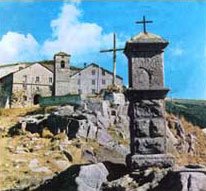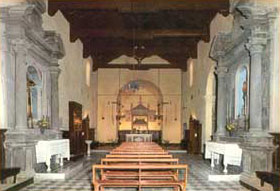St Pellegrino - the Irish Hermit of the Appenines

San Pellegrino in Alpe stands 4,584 feet (1525m) above sea level and has for centuries been an important stopping point on the road from Modena to Lucca. The poet Shelley came here in August 1820 and was inspired by the experience to write The Witch of Atlas. However, the mountaintop village is best known for the shrine of St Pellegrino and St Bianco.
According to tradition, Pellegrino (or Peregine) was the son of King Romanus and Queen Plantula of Scotia – often translated as ‘Scotland’ but probably referring to Ireland, whose people were confusingly referred to as Scotti. However, the legend frequently refers to the saint’s Scottish origins and as late as 1782 the Bologna Calendar even calls St Pellegrino ‘King of Scotland.’ At his baptism, the saint amazed the witnesses by answering ‘Amen’ to the prayers and the priest predicted a great future for the child. He grew up at the Court and was groomed to succeed his father as a Christian King. However, as a young man Pellegrino renounced his birthright, preferring the immortal crown of a pilgrim. And so, having bid farewell to his parents and distributed his wealth amongst the poor, the saint left his homeland and began his great pilgrimage.
His first stop was the Holy Land, where he prayed at the places sanctified by the life, death and resurrection of the Lord. Having visited these holy places, as well as the Monastery of St Catherine on Mount Sinai, Pellegrino furthered his imitation of Our Lord by spending forty years in the desert. Here he fasted, slept on a bed that resembled a tomb and battled with the temptations of the Devil.
Once he had advanced in holiness through this life of solitude and penance, Pellegrino went to preach at the Sultan’s court – for, the legend says, he had the eloquence of Cicero and the insight of Vergil. He was soon captured, led in chains to the mosque to offer worship and, when he refused to do this, imprisoned in a dark dungeon. After five days, he was miraculously freed by Christ Himself and went again to the Sultan, who proposed an ordeal by fire to establish the truth of Christianity. After thirteen hours in the flames, he remained unharmed and Pellegrino was set free, though he was disappointed that his efforts had won no converts to the Faith.
He boarded a ship bound for Italy and experienced a terrible storm, during which he was thrown into the sea by the sailors, who had been convinced by the devil that Pellegrino was the cause. However, thanks to the grace of God, all was not lost. His pilgrim’s garb miraculously turned into a ship – his cloak became a raft, his stick a mast and his purse a sail. He thus arrived at the port of Ancona and was able to visit the venerable sanctuaries of Rome, Bari (the tomb of St Nicholas) and Monte Gargano (the shrine of the Archangel Michael).
A star then led the holy pilgrim into the wilderness of the Appenines, where he lived for twelve years in a wood afterwards called ‘Romanesca.’ Here he worked many miracles and fought the devil, who tested him through the extremes of snow and rain. In the end, Pellegrino won and drove the evil spirits out of the dark woods and hills. He then went to live in a cave, where he was looked after by the leopards that lived nearby, and finally reached a place called Thermae Salonis. He wrote a brief spiritual testament on the bark of a tree and rested inside the trunk, which was hollow. It was here that Pellegrino died at the age of 97 years, nine months and 23 days.
The body remained inside the tree, untouched and indeed protected by the animals of the forest, until the saint’s resting place was revealed in a dream to a noble woman of the diocese of Modena, Adelgrada Ferniai. She and her husband went to the holy place and gave Pellegrino a fitting burial, the grave being dug by two leopards and bears. Devotion to St Pellegrino soon spread and the Tuscans and Lombards both tried to gain possession of the relics. The local bishops suggested that the body be placed on a cart and the oxen be allowed to go wherever they wanted. They stopped near the place the saint has died and a basilica was built and dedicated on 1 August 643 (which became the saint’s feast day).
The legend is, of course, fantastical. It contains numerous inaccuracies and contradictions: for example, the names of Pellegrino, Romano and Plantula are Latin rather than Celtic and appear nowhere in Scottish or Irish histories. There have never been leopards in the Appenines, and the bones of St Nicholas were only taken to Bari at the end of the eleventh century and so the shrine would not have existed at the time of Pellegrino’s supposed pilgrimage in the sixth or seventh century. The legend also contains many motifs that can be found in the lives of other saints. Childhood prodigies, renouncement of worldly power and riches, extreme penances, battles with Satan, miraculous escapes, closeness to nature and the discovery of the body through a vision are all common themes in hagiography.
It is also interesting to note that there are two saints with royal Irish connections venerated in nearby Lucca: St Frediano (son of the King of Ulster and bishop of Lucca in the late sixth century) and St Silaus (an Irish bishop who died at Lucca on his way back from Rome in 1100). The church of S Frediano also boasts the tomb of St Richard the Pilgrim, who is said to have been a King of Wessex who renounced his throne to go on pilgrimage to Rome. He died en route at Lucca in 722 and is chiefly remembered as the father of three saints, Willibald, Winnebald and Walburga, who helped evangelise Southern Germany.
What, then, are we to make of the story of St Pellegrino? The earliest mention of the church of San Pellegrino dates from 1110 and the presence of the saint’s body is first recorded in 1255. The church was attached to a hospice for pilgrims who were travelling along this high point of the Via Francigena towards Rome (part of the medieval hospice now houses the Museo Etnografico Provinciale ‘Don Luigi Pellegrini’). However, the legend of St Pellegrino is only first mentioned in a fifteenth century manuscript, which also includes the Mass and Office for the saint and may be the work of Lionella de Nobilii, a kinsman of Pope Nicholas V (1447-55) and Commendatory (or Superior) of the Hospice, who restored the buildings and thus had a vested interest in promoting the cult. The story of St Pellegrino provided, above all, a spiritual message to pilgrims making an arduous and dangerous journey – the saint persevered despite the obstacles of demons, severe weather, savage beasts, hunger, thirst and human threats.
But was St Pellegrino an historical figure? There is no reason to doubt the existence of an Irish (or Scottish) pilgrim who ended his days in the wilderness of the Tuscan Emilian Appenines in the second half of the First Millennium. From the sixth century, numerous Irishmen trusted in Providence and became ‘voluntary exiles’ by leaving their homelands and going on a peregrinatio pro Dei amore – a ‘wandering for the love of God.’ Many of these are still venerated in France, Germany, Austria, Switzerland and Italy, and they may even have reached North America, if one believes the story of the voyage of St Brendan. The fame of these holy men was such that the term ‘pilgrims’ (peregrini) came to denote the Irish and it is little surprise that a generic name like ‘San Pellegrino’ was used for our saint, in the absence of his baptismal name. It has been suggested that St Pellegrino is the same person as another local saint, St Viviano (or Viano), a hermit who is venerated at Vagli Sopra in Garfagnana and whose cave can still be visited. Some scholars argue that the hospice of San Pellegrino was initially dedicated to another St Pellegrino, a third century bishop of Auxerre who was particularly popular among French pilgrims. It is thought that a medieval carving kept at San Pellegrino shows the bishop of Auxerre blessing a pilgrim. Devotion to this saint was then linked to the local memory of a holy Irish pilgrim. Added to this were the relics of catacomb martyrs brought to Lucca in the eighth century, including a St Pellegrino, whose body may be the one venerated today at San Pellegrino in Alpe. As noted above, the relics are first mentioned in 1255 and by the sixteenth century St Pellegrino had gained a companion or disciple, St Bianco, who is not mentioned in the original versions of the legend. He is first mentioned in an Epicopal Visitation of 1559 and, sixteen years later, the bishop of Rimini is recorded as celebrating Mass in a separate chapel of St Bianco. His feast was celebrated on 3 March.
Some scholars argue that the hospice of San Pellegrino was initially dedicated to another St Pellegrino, a third century bishop of Auxerre who was particularly popular among French pilgrims. It is thought that a medieval carving kept at San Pellegrino shows the bishop of Auxerre blessing a pilgrim. Devotion to this saint was then linked to the local memory of a holy Irish pilgrim. Added to this were the relics of catacomb martyrs brought to Lucca in the eighth century, including a St Pellegrino, whose body may be the one venerated today at San Pellegrino in Alpe. As noted above, the relics are first mentioned in 1255 and by the sixteenth century St Pellegrino had gained a companion or disciple, St Bianco, who is not mentioned in the original versions of the legend. He is first mentioned in an Epicopal Visitation of 1559 and, sixteen years later, the bishop of Rimini is recorded as celebrating Mass in a separate chapel of St Bianco. His feast was celebrated on 3 March.
Through a complex of factors, then, the memory of an Irish pilgrim and hermit became mixed with the Hospice’s dedication to St Pellegrino of Auxerre and the translation of the bodies of Roman martyrs to Lucca. By the fifteenth and sixteenth centuries, an elaborate legend had been formulated and St Pellegrino had gained a disciple, St Bianco, who lies beside his master in the shrine church.
Whatever the truth and whatever the conclusions of modern scholars, there is much to admire in the life of the saint and we can truly say (especially after my experience driving down from his shrine): St Pellegrino, pray for us who have recourse to thee.
Labels: Saints



<< Home